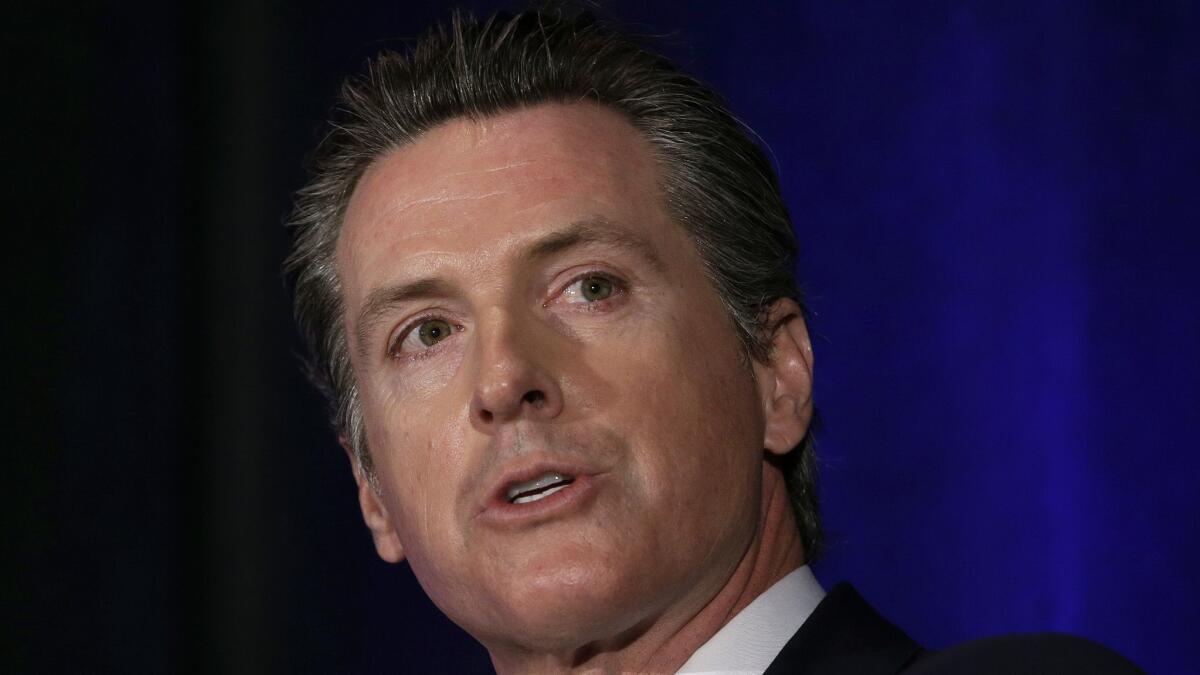On Politics: Been ignoring the race for California governor? That’s OK, in some ways it’s just starting

- Share via
On a recent trip to Iowa, Eric Garcetti — the mayor of Los Angeles and a possible 2020 White House contestant — raised eyebrows with a bit of exuberant outreach.
Los Angeles and Iowa, Garcetti insisted, “have a ton in common,” and he didn’t simply mean both are inhabited by carbon-based life forms needing oxygen to survive.
Urban or rural, farmer or fashion plate, all of us harbor the same hopes and dreams, the mayor suggested, and if it wasn’t a terribly original thought it also wasn’t the most egregious sort of political pandering — like, say, ordering that every home in Los Angeles be powered by Iowa-produced ethanol.
There is one particular way in which California has come to resemble Iowa: the dynamic in the state’s widely overlooked race for governor.
With just over five weeks to the June 5 primary, and less than two weeks before voting by mail begins, the contest has turned into a mad dash reminiscent of Iowa’s presidential caucuses, where the formula for winning, as a popular saying goes, is to organize, organize, organize and get hot at the end.
There are, of course, vast differences between Iowa and California — with all due respect to his honor, the mayor — and not just the winter weather or number of plastic surgeons.
The caucuses, the first vote of the presidential contest, are an up-close-and-personal experience. Candidates are expected to campaign in the flesh, preferably early and often, giving voters a chance to interact on an intimate level. (For Donald Trump, this meant giving kids helicopter rides at the Iowa State Fair.)
In California — 800 miles long, 250 miles wide, population pushing 40 million — it’s possible to spend a lifetime without inhabiting the same ZIP Code as a candidate for governor. A close encounter with a presidential contender might consist of stewing in traffic as his, or her, motorcade comes whizzing past.
Indeed, on a recent road trip across the length and breadth of the state, reporters for the L.A. Times conducted more than 125 random interviews and, lo, the overwhelming majority of residents had little or no clue as to who was seeking the state’s top job. Most couldn’t even name a single candidate.
Joe Vega, a 45-year-old television producer from Venice, was typical. “Since Trump got elected, I haven’t been in tune as much with the news,” said the self-described independent as he enjoyed a Sunday lunch in Santa Monica. “It’s too absurd what’s going on.”
The way most voters get to know candidates running statewide is through the glossy mailers they send, or in the 30- to 60-second dollops they appear on TV, computer monitors or smartphone screens; another old political saying holds that a political rally in California consists of three people gathered around a television set.
Which means that for most Californians the race for governor is just starting, as the first widely broadcast commercials — emergent like the first shoots of spring, but much less lovely — begin to fill the airwaves.
As it stands, the race appears to be a contest between Lt. Gov. Gavin Newsom, the Democratic front-runner, and the remainder of the field vying to win one of two top-finishing slots. (A brief refresher: Under California’s primary system, first put in effect in 2012, the two candidates receiving the most votes will advance to a November runoff, regardless of their political parties.)
On the Democratic side, the leading contenders are former Los Angeles Mayor Antonio Villaraigosa, state Treasurer John Chiang and former state schools superintendent Delaine Eastin. Among Republicans, the two major candidates are businessman John Cox and state Assemblyman Travis Allen of Huntington Beach.
Newsom enjoys certain inherent advantages, not least his pedigree as a former San Francisco mayor; the Bay Area, which is far more politically cohesive than Southern California, routinely favors its homegrown candidates.
But there’s enough history to hold out the prospect of a surprise, or two.
In 1990, another ex-San Francisco mayor, Dianne Feinstein, was flailing in her bid for governor. (Things got so bad the candidate was fired by her campaign manager.) Then a grab-’em-by-the-throat TV spot, opening with Feinstein’s anguished announcement of the 1978 assassinations of Mayor George Moscone and Supervisor Harvey Milk, helped her vault past the front-running John Van de Kamp to capture the Democratic nomination.
Although Feinstein eventually lost the contest to Republican Pete Wilson, that race made her a shoo-in two years later for the U.S. Senate seat she still holds today.
In 1998, then-Lt. Gov. Gray Davis, underfunded and charismatic as a plate of vanilla wafers, lagged far back in the polls against two big-spending millionaires, fellow Democrats Al Checchi and Jane Harman. The front-runners savaged one another, clearing the way for Davis to surge in the last weeks of the campaign, win the nomination and, ultimately, the governor’s office.
With so many undecided — not to mention inattentive — voters, this year’s gubernatorial contest remains far from settled. Whoever advances on June 5 may do so taking a page from the Iowa political playbook and giving it a California twist: Advertise, advertise, advertise and get hot at the end.
@markzbarabak on Twitter
ALSO
He struck out at baseball, but made it big in politics. Now he’s returned to his first love
Why the rise of the independent voter is a political myth
More to Read
Get the L.A. Times Politics newsletter
Deeply reported insights into legislation, politics and policy from Sacramento, Washington and beyond. In your inbox three times per week.
You may occasionally receive promotional content from the Los Angeles Times.











